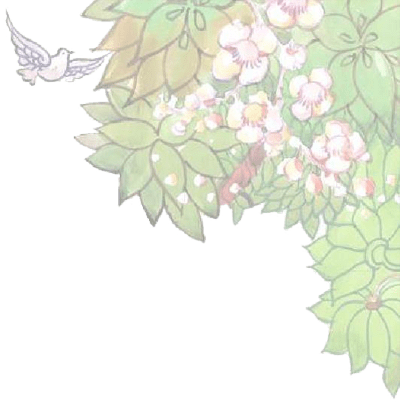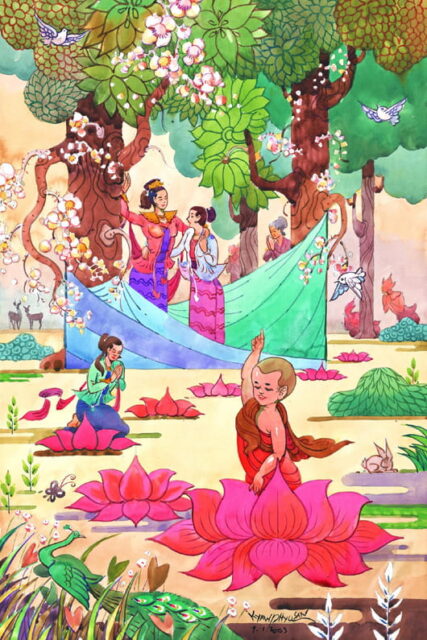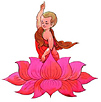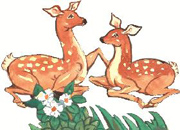04話 生地ルンビニー・・・・菩薩降誕

第1部 出家まで
第2章 生誕
04話 生地ルンビニー・・・・菩薩降誕

懐妊から十か月たったころ、王妃は親族のいるデーヴァダハへ里帰りしたいという気持ちに駆られた。インドではその当時、出産は実家でするのがならわしだった。里帰りの許しをもとめて、スッドーダナ王にこういった。
「おお偉大なる王さま、わたしは父の都デーヴァダハへ行きとうございます。わたしの赤ちゃんが、今にも生まれそうでございますから」
王はこれを承認し「たいへん、けっこうなことだ。そなたの旅の十分な準備を命じよう」と、いった。
王は近衛の従者たちに、カピラヴァットゥからデーヴァダハに至る道をきれいに整え、直し、旗や幟で飾るように命じた。王家の家来たちには、王妃を新しい黄金の輿に乗せて、大勢のお供を連れていくようにさせた。このように王妃は、王の命じた絢爛豪華な準備のもと、デーヴァダハへ送り出された。
さて、王妃の旅の行列はカピラヴァットゥとデーヴァダハの中間にあるルンビニー園というサーラ樹(原注:ラテン語Shorea robusta、沙羅の木)の林にさしかかった。ここは釈迦、コーリヤ両王国の人びとが行楽のためにしばしば訪れるところだった。その夏のあいだ中、ルンビニー園のどのサーラ樹のどこの枝にも、淡い黄色のちいさな花がびっしり一面に咲いていた。
五色のミツバチの群れがサーラ樹の花の周りをブンブン飛びまわり、たくさんの種類の鳥たちは甘い調べで歌うように囀っていた。サーラ樹の花のかぐわしい香りはルンビニー園のあらゆる方向へひろがり、まるでみんなに、その美しさを見にきて楽しんでください、と誘っているかのようだった。そうしたすべてが園全体を神々の王である帝釈天のチッタラター園のように見せているのだった。
輿が園の中を通っているとき、マハーマーヤー妃はそのみごとな眺めを見て、少し休憩して、サーラ樹の涼しい木陰でしばらく眺めを楽しみたくなった。黄金の輿から降りて、林をそぞろ歩いた。花が満開のサーラ樹の下で、王妃は枝の一つをつかむため右手をさしのべた。ふしぎな出来事が多くのものたちの心を強く動かしたのだが、まっすぐの枝がひとりでに籐の茎のように曲がって王妃の手のひらにまで届いたのである。まさにその瞬間、王妃は分娩の陣痛を感じた。侍女たちは急いで幕を掛け、まわりに引いて、周囲をさえぎった。かくして王妃はサーラ樹の枝をしっかり握りしめているうちに、立ったままの姿勢で男の子を出産した。紀元前623年、ウェーサーカー月(現代暦の五月ごろ)の満月の日だった。
清らかな温かい水と冷たい水の二つの噴水がほとばしって、空から降りそそぎ、礼讃のしるしとして、すでに清らかできれいな菩薩(ボーディサッタ)と母親のからだの上に落ちた。
そのとき菩薩(ボーディサッタ)はしっかり自分の足で立ち、十方向を調べ、菩薩(ボーディサッタ)よりすぐれたものは誰もいないことを確認した。それからすぐに、北へ向いて、七歩前に歩んだ。足跡が着くたび、その地面の上に、ハスの花が一輪ずつ現れた。
菩薩(ボーディサッタ)は七歩目で止まり、右手を頭上に挙げ、なにものをも恐れず、咆哮した。
“Aggo’haṃasmi lokassa! (アッゴーハマスミ ローカッサ)
Jeṭṭho’haṃasmi lokassa! (ジェットーハマスミ ローカッサ)
Seṭṭho’haṃasmi lokassa! (セットーハマスミ ローカッサ)
Ayaṃantima jāti! (アヤマンティマ ジャーティ)
Natthi dāni punabbhavo!” (ナッティ ダーニ プナッバヴォー)
「わたしは、この世の頂点に立ってしまった!
わたしは、この世の最長老になってしまった!
わたしは、この世で最も勝れたものになってしまった!
これが最後の生である!
もはや二度と生まれることはない!」
菩薩降誕と同時に、他に七つの存在がこの世に誕生した。ヤソーダラー王女(将来の妻でラーフラの母)、アーナンダ王子、御者チャンナ、大臣カールダーイー、王家の馬カンタカ、菩提樹、四つの宝瓶 (ニディクンバー)、である。
男の子の生誕後、マハーマーヤー妃と菩薩はカピラヴァットゥに帰った。この吉報をきいて、スッドーダナ王はとても幸福だった。カピラヴァットゥのすべての人びととともに、王は新王子を、歓喜して迎えたのであった。
※ 画像やテキストの無断使用はご遠慮ください。/ All rights reserved.

Episode 04. THE BIRTH OF THE BODHISATTA IN Lumbinī
When the age of her pregnancy was ten months old, the queen felt an urge to visit Devadaha, the city of her royal relatives. It was the custom in India at that time for a wife to give birth in her father’s house. She asked for permission from King Suddhodana, saying: “O great king, I wish to go to Devadaha, the city of my father. My baby is about due now.” The king gave his assent, saying: “Very well, I will have adequate preparations made for your journey.”
The king ordered the soldiers of royal attendants to clean up, repair and decorate the roads from Kapilavatthu to Devadaha with flags and banners. He had the queen seated on a new golden palanquin carried by royal servants and accompanied by a large retinue. Thus, the queen was sent off by the king to Devadaha with pomp and grandeur.
Now, the royal procession was passing through a pleasure grove of sāla (Shorea robusta) trees, called the Lumbinī Park, situated between Kapilavatthu and Devadaha. This park was frequented by people from both kingdoms for recreation. During that summer, every sāla tree in the park was blooming all over the branches.
Swarms of honeybees in five colours were humming around the flowers of the sāla trees, and birds of many species were chirping sweet melodies. The fragrance of the sāla flowers was spreading to all directions of the park, as if inviting everyone to come and enjoy its beauty. All that made the whole park seem like the Cittalatā Garden of Sakka, the king of devas.
As the palanquin was passing through the park, Queen Mahāmāyā saw its splendour and felt a desire to take a rest and amuse herself for a while in the cool shade of the sāla trees. Alighting from her golden palanquin, she walked about the grove. Under a fully blooming sāla tree, she outstretched her right hand to grasp one of its branches. A marvelous event stirred up the minds of many as the straight branch bent down by itself like a cane stalk until it reached the queen’s palm. At that very moment, she felt the pangs of child birth. Her attendants hastily cordoned off the area with curtains and withdrew. Thus, while holding on to the branch of the sāla tree, she delivered a baby boy in a standing position. It was on the full-moon day of Vesākha, in the year 623 B.C.
Two fountains of pure spring water, warm and cold, showered down from the sky and fell on the already pure and clean bodies of the Bodhisatta and the mother as a token of homage.
Then, the Bodhisatta stood firmly on his feet and examined the ten directions, seeing no one superior to him. Thereupon, he faced northward and took seven steps forward, with a lotus flower appearing on the ground under each of his footsteps.
The Bodhisatta halted at the seventh step, raising his right hand
over his head and made a fearless roar:
“Aggo’haṁ asmi lokassa!
Jeṭṭho’haṁ asmi lokassa!
Seṭṭho’haṁ asmi lokassa!
Ayaṁ antima jāti!
Natthi dāni punabbhavo!”
“I am the most superior in the world!
I am the greatest in the world!
I am the most exalted in the world!
This is my last birth!
There is no more rebirth for me!”
At the same time as the birth of the Bodhisatta, there also came into existence seven other beings. They were: Princess Yasodharā (his future wife and mother of Rāhula), Prince Ānanda, his charioteer Channa, Minister Kāḷudāyī, his royal horse Kanthaka, the Bodhi tree and four treasure pots (Nidhikumbhī).
As the baby son had been born, Queen Mahāmāyā and the Bodhisatta returned to Kapilavatthu. Having heard this good news, King Suddhodana was very happy. Together with all the citizens of Kapilavatthu, he greeted the new prince with great rejoicing.
※ 画像やテキストの無断使用はご遠慮ください。/ All rights reserved.
アシン・クサラダンマ長老
1966年11月21日、インドネシア中部のジャワ州テマングン生まれ。中国系インドネシア人。テマングンは近くに3000メートル級の山々が聳え、山々に囲まれた小さな町。世界遺産のボロブドゥール寺院やディエン高原など観光地にも2,3時間で行ける比較的涼しい土地という。インドネシア・バンドゥンのパラヤンガン大学経済学部(経営学専攻)卒業後、首都ジャカルタのプラセトエイヤ・モレヤ経済ビジネス・スクールで財政学を修め、修士号を取得して卒業後、2年弱、民間企業勤務。1998年インドネシア・テーラワーダ(上座)仏教サンガで沙弥出家し、見習い僧に。詳しく見る
奥田 昭則
1949年徳島県生まれ。日本テーラワーダ仏教協会会員。東京大学仏文科卒。毎日新聞記者として奈良、広島、神戸の各支局、大阪本社の社会部、学芸部、神戸支局編集委員などを経て大阪本社編集局編集委員。1982年の1年間米国の地方紙で研修遊学。2017年ミャンマーに渡り、比丘出家。詳しく見る

※ 画像やテキストの無断使用はご遠慮ください。
All rights reserved.

